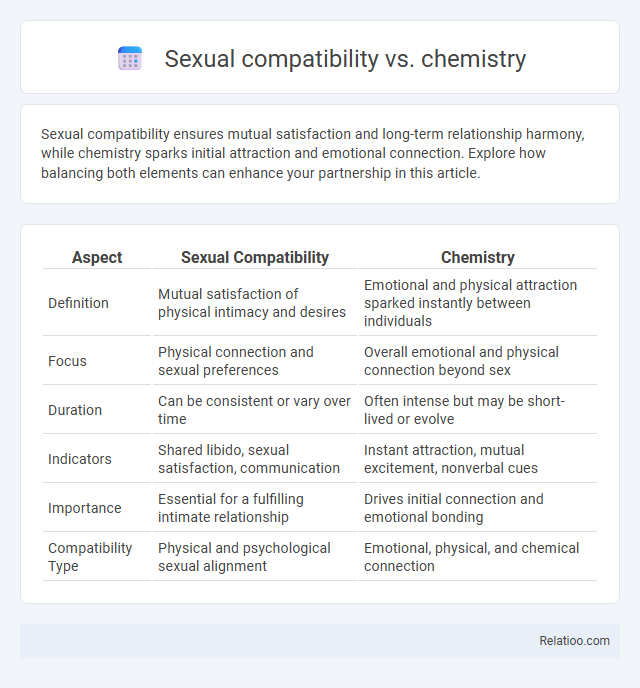Sexual compatibility ensures mutual satisfaction and long-term relationship harmony, while chemistry sparks initial attraction and emotional connection. Explore how balancing both elements can enhance your partnership in this article.
Table of Comparison
| Aspect | Sexual Compatibility | Chemistry |
|---|---|---|
| Definition | Mutual satisfaction of physical intimacy and desires | Emotional and physical attraction sparked instantly between individuals |
| Focus | Physical connection and sexual preferences | Overall emotional and physical connection beyond sex |
| Duration | Can be consistent or vary over time | Often intense but may be short-lived or evolve |
| Indicators | Shared libido, sexual satisfaction, communication | Instant attraction, mutual excitement, nonverbal cues |
| Importance | Essential for a fulfilling intimate relationship | Drives initial connection and emotional bonding |
| Compatibility Type | Physical and psychological sexual alignment | Emotional, physical, and chemical connection |
Understanding Sexual Compatibility
Understanding sexual compatibility involves recognizing how well partners' desires, preferences, and boundaries align, which is essential for a satisfying intimate relationship. While chemistry refers to the immediate, often physical attraction and connection between partners, sexual compatibility is deeper, encompassing communication, mutual satisfaction, and emotional comfort. Your ability to openly discuss needs and expectations can significantly enhance sexual compatibility and overall relationship satisfaction.
Defining Sexual Chemistry
Sexual chemistry refers to the intense physical and emotional connection between partners that creates attraction and desire, often sparked by shared energy and mutual responsiveness. Sexual compatibility, in contrast, involves how well partners' sexual preferences, needs, and frequencies align, contributing to long-term satisfaction. While chemistry ignites passion, compatibility sustains a harmonious sexual relationship through understanding and communication.
Key Differences Between Compatibility and Chemistry
Sexual compatibility refers to the alignment of preferences, desires, and boundaries that create a satisfying physical relationship, while chemistry is the immediate, often inexplicable attraction that sparks intense emotional and physical connection. Compatibility tends to develop and deepen over time through communication and understanding, whereas chemistry can be instantaneous but may not guarantee long-term fulfillment or harmony. Understanding these key differences helps you identify whether a relationship has the potential for lasting intimacy or is driven primarily by initial passion.
The Role of Communication in Sexual Compatibility
Effective communication plays a crucial role in sexual compatibility by allowing partners to express desires, boundaries, and needs openly, fostering mutual understanding and satisfaction. Unlike chemistry, which is often characterized by instinctive attraction and emotional connection, sexual compatibility is nurtured through ongoing dialogue and feedback. Consistent, honest communication helps partners navigate differences, build trust, and create a fulfilling sexual relationship grounded in respect and empathy.
Emotional Connection vs Physical Attraction
Sexual compatibility refers to how well partners' sexual needs and preferences align, while chemistry emphasizes the natural, often immediate, physical attraction between individuals. Emotional connection plays a crucial role in sexual compatibility by fostering trust, communication, and mutual understanding, which enhance intimacy and satisfaction. In contrast, physical attraction or chemistry can spark initial desire but may not sustain long-term sexual fulfillment without a strong emotional bond.
How Chemistry Influences Initial Attraction
Chemistry plays a crucial role in initial attraction by triggering a natural, often subconscious connection through physical and emotional signals, such as pheromones and body language. This immediate spark can create excitement and curiosity, enticing Your desire to explore further interactions. Sexual compatibility, in contrast, develops over time as partners learn about each other's preferences and boundaries, which solidifies long-term satisfaction beyond the initial chemistry.
Building Sexual Compatibility in Relationships
Building sexual compatibility in relationships involves open communication about desires, boundaries, and preferences to ensure mutual satisfaction and trust. Chemistry spark initial attraction, but sustainable sexual compatibility requires ongoing effort to understand and adapt to each partner's evolving needs. Prioritizing emotional connection alongside physical intimacy enhances long-term sexual fulfillment and relationship stability.
Signs of Strong Sexual Chemistry
Signs of strong sexual chemistry include intense mutual attraction, effortless physical connection, and synchronized responses during intimacy. Partners with strong chemistry often experience heightened arousal, spontaneous desire, and deep emotional engagement, setting a foundation for fulfilling sexual compatibility. This chemistry enhances communication and trust, distinguishing it from mere compatibility, which relies more on shared values and long-term sexual harmony.
Navigating Relationship Challenges: Compatibility vs. Chemistry
Navigating relationship challenges requires understanding the critical differences between sexual compatibility and chemistry, where chemistry ignites passion and immediate attraction, but sexual compatibility ensures long-term satisfaction and mutual fulfillment. Your relationship thrives when you balance chemistry's spark with compatibility's alignment in desires, boundaries, and emotional connection, reducing conflicts related to intimacy. Prioritizing compatibility over fleeting chemistry helps maintain a healthier, more sustainable partnership even during difficult moments.
Achieving Balance: Integrating Compatibility and Chemistry
Achieving balance between sexual compatibility and chemistry involves harmonizing emotional connection with physical attraction to foster a satisfying intimate relationship. Sexual compatibility includes aligned desires, preferences, and boundaries, while chemistry refers to the spontaneous physical and emotional spark that ignites passion. Integrating these elements enhances relationship durability by ensuring both mutual satisfaction and dynamic connection.

Infographic: Sexual compatibility vs Chemistry
 relatioo.com
relatioo.com